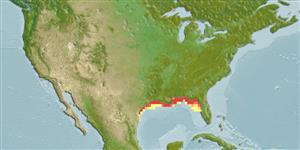>
Clupeiformes (Herrings) >
Alosidae (Shads and Sardines)
Etymology: Alosa: Latin, alausa = a fish cited by Ausonius and Latin, halec = pickle, dealing with the Greek word hals = salt; it is also the old Saxon name for shad = "alli" ; 1591 (Ref. 45335); chrysochloris: From the words chryso, meaning gold and chloris, meaning green (Ref. 10294).
More on author: Rafinesque.
Environment: milieu / climate zone / depth range / distribution range
Ecologie
marien; zoet water; brak water; anadroom (Ref. 51243). Subtropical; 45°N - 23°N, 100°W - 82°W (Ref. 188)
Western Central Atlantic: Gulf of Mexico (from Corpus Christi in Texas eastward to Pensacola in Florida; also in rivers, e.g. Mississippi and Ohio Rivers to Minnesota, Wisconsin and Pennsylvania).
Grootte / Gewicht / Leeftijd
Maturity: Lm ? range ? - ? cm
Max length : 50.0 cm SL mannelijk / geslacht onbekend; (Ref. 188); common length : 37.5 cm SL mannelijk / geslacht onbekend; (Ref. 188); max. gepubliceerd gewicht: 1.7 kg (Ref. 4699); max. gerapporteerde leeftijd: 4 Jaren (Ref. 12193)
Dorsale stekels (totaal) : 0; Anale stekels: 0. Belly with a distinct keel of scutes. Lower jaw not rising steeply within mouth; teeth prominent at front of lower jaw. Lower gill rakers slender. Back bluish green, abruptly changing to silver on flank; no dark spot at shoulder. Closely resembles A. mediocris of Atlantic coasts, which has no upper and weak lower jaw teeth, a dark shoulder spot and the body deeper than head length (Ref. 188).
Generally present in coastal marine water (Ref. 37039). Enter brackish- and freshwaters, but perhaps not always or not consistently anadromous (Ref. 188), although strongly migratory within rivers (Ref. 10294) , mostly in fast-flowing water where they are renowned for leaping. Feed on small fishes, the juveniles on insects. Spawning times and places not certain. Adults serve as hosts to the larvae (glochidia) of the economically valuable pearly mussel (Fusconaia ebena) of the Mississippi basin (Ref. 188).
Whitehead, P.J.P., 1985. FAO Species Catalogue. Vol. 7. Clupeoid fishes of the world (suborder Clupeoidei). An annotated and illustrated catalogue of the herrings, sardines, pilchards, sprats, shads, anchovies and wolf-herrings. FAO Fish. Synop. 125(7/1):1-303. Rome: FAO. (Ref. 188)
Status op de Rode Lijst van het IUCN (Ref. 130435)
Gevaar voor de mens
Harmless
Gebruik door de mens
Visserij: van minder commercieel belang; sportvis: ja
Tools
Speciale rapporten
Download XML
Internetbronnen
Estimates based on models
Preferred temperature (Ref.
123201): 23.1 - 24.6, mean 23.9 °C (based on 126 cells).
Fylogenetische diversiteitsindex (Ref.
82804): PD
50 = 0.5000 [Uniqueness, from 0.5 = low to 2.0 = high].
Bayesian length-weight: a=0.00646 (0.00371 - 0.01125), b=2.99 (2.85 - 3.13), in cm total length, based on LWR estimates for this species & Genus-body shape (Ref.
93245).
Trofisch niveau (Ref.
69278): 3.9 ±0.63 se; based on food items.
Weerstandsvermogen (Ref.
120179): Gemiddeld, minimale populatieverdubbelingstijd 1,4-4,4 jaar (tmax=4).
Fishing Vulnerability (Ref.
59153): Moderate vulnerability (44 of 100).
